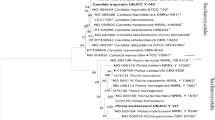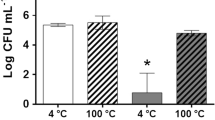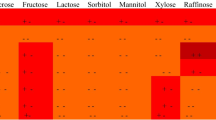Abstract
Yeasts form a natural and dominant surface flora on the cashew apple and fermented cashew apple juice due to its rich nutritional content. In the present study, yeast flora from naturally fermented cashew apple juice was studied. Based on different colony characters on potato dextrose agar, 11 different types of yeasts were isolated. The yeast strain ICARG 16 was further characterized and based on morphological, biochemical and 26S rDNA sequencing. The strain was identified as Pichia membranifaciens. The antimicrobial activity of cell free extract of the strain ICARG 16 was studied against Staphylococcus aureus MTCC 1144 and found to inhibit the growth of the pathogen. The isolate could tolerate 10 % of ethanol, showed growth at 27 °C, in 50 % glucose. The strain did not exhibit amylase, protease, pectinase and cellulase activity, however, it showed urease activity. Thus the naturally occurring yeast isolates P. membranifaciens ICARG16 may be of pharmaceutical interest.


Similar content being viewed by others
References
Talasila U, Vechalapu RR, Shaik KB (2011) Preservation and shelf life extension of cashew apple juice. Inter J Food Safety 13:275–280
Deenanath ED, Rumbold K, Iyuke S (2013) The production of bioethanol from cashew apple juice by batch fermentation using Saccharomyces cerevisiae Y2084 and Vin13. ISRN Renew Ener 2012:1–11
Pires AM, Macedo AC, Eguchi SY, Santana MH (2010) Microbial production of hyaluronic acid from agricultural resource derivatives. Bioresour Technol 101:6506–6509
Santos A, San Mauro M, Bravo E, Marquina D (2009) PMKT2, a new killer toxin from Pichia membranifaciens, and its promising biotechnological properties for control of the spoilage yeast Brettanomyces bruxellensis. Microbiol 155:624–634
Marquina D, Peres C, Caldas FV, Marques JF, Peinado JM, Spencer-Martins I (1992) Characterization of the yeast populations in olive brines. Lett Appl Microbiol 14:279–283
Chavan P, Mane S, Kulkarni G, Shaikh S, Ghormade V, Nerkar D, Shouche Y, Deshpande M (2009) Natural yeast flora of different varieties of grapes used for wine making in India. Food Microbiol 26:801–808
Santos A, Marquina D (2004) Killer toxin of Pichia membranifaciens and its possible use as a biocontrol agent against grey mould disease of grapevine. Microbiol 150:2527–2534
Arias CR, Burns JK, Friedrich LM, Goodrich RM, Parish ME (2002) Yeast species associated with Orange juice : evaluation of different identification methods. Appl Environ Microbiol 68:1955–1961
Warnasuriya D, Liyanage AW, Weerawansa GG, Athauda PK, Jayatissa PM (1985) Isolation and characterization of yeasts of some fruits and fruit products of Sri Lanka. J Nat Sci 13:71–75
Noroul Asyikeen Z, Maaruf AG, Sahilah AM, Khan MA, Wan Aida WM (2013) A new source of Saccharomyces cerevisiae as a leavening agent in bread making. Int Food Res J 20:967–973
Lopes MB, Soden A, Martens AL, Henschke PA, Langridge P (1998) Differentiation and species identification of yeasts using PCR. Int J Syst Microbiol 48:279–286
Fakruddin M, Ariful IM, Abdul QM, Ahmed MM, Chowdhury N (2013) Characterization of stress tolerant high potential ethanol producing yeast from agro-industrial waste. Amer J Biosci 1:24–34
Kurtzman C, Robnett J, Basehoar-Powers E (2008) Phylogenetic relationships among species of Pichia, Issatchenkia and Williopsis determined from multigene sequence analysis, and the proposal of Barnettozyma gen. nov., Lindnera gen. nov. and Wickerhamomyces gen. nov. FEMS Yeast Res 8:939–954
Kurtzman CP (1998) Pichia E.C. Hansen emend. Kurtzman. In: Kurtzman CP, Fell JW (eds) The yeasts, a taxonomic study, 4th edn. Elsevier, Amsterdam, pp 273–352
Yalcin HT, Corbaci C (2013) Isolation and characterization of amylase producing yeasts and improvement of amylase production. Turk J Biochem 38:101–108
Buzzini P, Martini A (2002) Extracellular enzymatic activity profiles in yeast and yeast-like strains isolated from tropical environments. J Appl Microbiol 93:1020–1025
Oliveira KF, Malavolta L, Souza CS, Vicente EJ, Laluce C (2006) Pectinolytic activity secreted by yeasts isolated from fermented citrus molasses. J Appl Microbiol 100:633–640
Goldbeck R, Andrade CCP, Pereira GAG, Maugeri Filho F (2012) Screening and identification of cellulase producing yeast-like microorganism from Brazilian biomes. African J Biotechnol 11:11595–11603
Hamedani K, Soudbaksh NM, Das A, Prashanthi K, Bhattacarya S, Suryan S (2012) Enzymatic screening, antibacterial potential and molecular characterization of Streptomycetes isolated from Wayanad District in Kerala, India. Int J Pharm Bio Sci 2:201–210
Montville TJ (1983) Dual substrate plate diffusion assay for proteases. Appl Environ Microbiol 45:200–204
Seeliger HPR (1956) Use of a urease test for the screening and identification of Cryptococci. J Bacteriol 72:127–131
Bharti P, Anand V, Chander J, Singh IP, Singh VT, Tewari R (2012) Heat stable antimicrobial activity of Burkholderia gladioli against clinical drug resistant isolates. Indian J Med Res 135:666–671
Liu S, Miao Z, Tang Y, Li C (2011) Antimicrobial activity of cashew (Anacardium occidentale L.) apple ethanol extracts. Adv Biomed Eng 1–2:335–337
Aguiar C, Lucas C (2000) Yeasts killer/sensitivity phenotypes and halotolerance. Food Technol Biotechnol 38:39–46
Carlsen H, Degn H, Lioyd D (1991) Effects of alcohols on the respiration and fermentation of aerated suspensions of baker’s yeast. J Gen Microbiol 137:2879–2883
Tikka C, Osuru HP, Atluri N, Raghavulu PC, Yellapu NK, Mannur IS, Prasad UV, Aluru S, Varma N, Bhaskar M (2013) Isolation and characterization of ethanol tolerant yeast strains. Bioinformation 9:421–425
Lachance MA (1995) Yeast communities in natural tequila fermentation. Antonie Van Leeuwenhoek 68:151–160
Molnarova J, Vadkertiova R, Slavikova E, Stratilova E, Illkova K (2011) The enzymatic activity of yeasts isolated from plant material. Poster PH3. 39th Annual Conference on Yeasts, Smolenice, Slovakia, 3–6 May 2011
Madrigal T, Maicas S, Tolosa JM (2012) Glucose and ethanol tolerant enzymes produced by Pichia (Wickerhamomyces) isolates from enological ecosystems. Am J Enol Vitic 64:126–133
Heard GM, Fleet GH (1987) Occurrence and growth of killer yeasts during wine fermentations. Appl Environ Microbiol 53:2171–2174
Bajaj BK, Raina S, Singh S (2013) Killer toxin from a novel killer yeast Pichia kudriavzevii RY55 with idiosyncratic antibacterial activity. J Basic Microbiol 53:645–656
Masih EI, Slezack-Deschaumes S, Marmaras I, Ait Barka E, Vernet G, Charpentier C, Adholeya A, Paul B (2001) Characterisation of the yeast Pichia membranifaciens and its possible use in the biological control Botrytis cinerea, causing the grey mould disease of grapevine. FEMS Microbiol Lett 202:227–232
Ghosh S, Santra TK, Chakravarty A (2013) Study of antagonistic yeasts isolated from some natural sources of West Bengal. Agri Biol J N Am 4:33–40
Acknowledgments
The authors thank Director, ICAR Research Complex for Goa, Old Goa, India for providing facilities for the work. The work was supported by grants from Department of Biotechnology, Government of India under rural development.
Author information
Authors and Affiliations
Corresponding author
Rights and permissions
About this article
Cite this article
Prabhu Khorjuvenkar, S.N., Doijad, S.P., Poharkar, K. et al. Antimicrobial Activity of a Novel Pichia membranifaciens Strain Isolated from Naturally Fermented Cashew Apple Juice. Proc. Natl. Acad. Sci., India, Sect. B Biol. Sci. 86, 125–129 (2016). https://doi.org/10.1007/s40011-014-0417-5
Received:
Revised:
Accepted:
Published:
Issue Date:
DOI: https://doi.org/10.1007/s40011-014-0417-5




